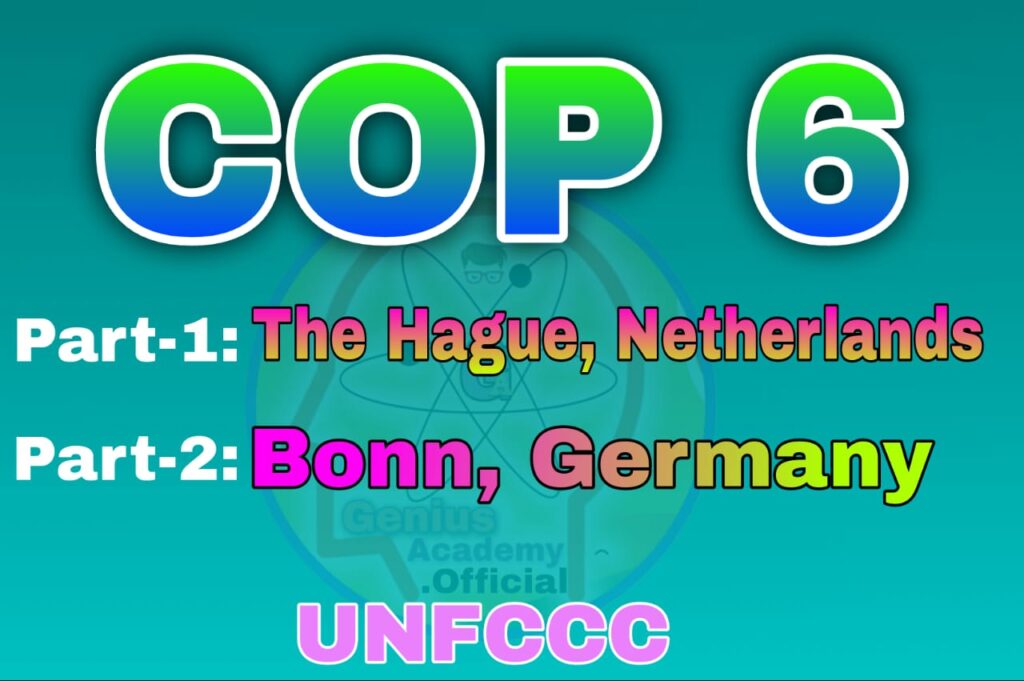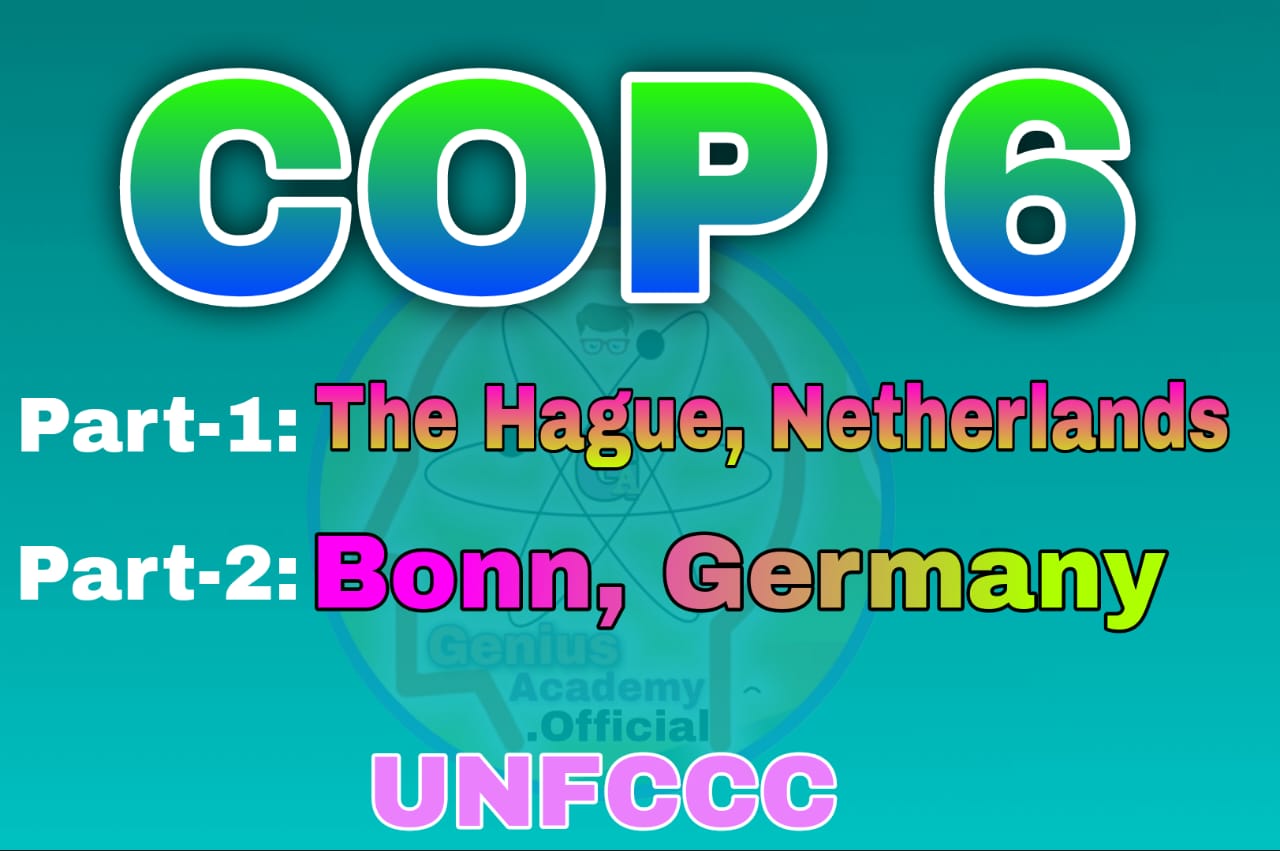
UNFCCC COP-6
The Sixth Conference of the Parties (COP-6) to the United Nations Framework Convention on Climate Change (UNFCCC) took place in The Hague, Netherlands (Part 1), from November 13 to 25, 2000. It marked a crucial attempt to finalize the operational guidelines for commitments under the 1997 Kyoto Protocol and enhance the overall implementation of the UNFCCC. Over 7,000 participants attended, including representatives from 182 governments, 323 intergovernmental and non-governmental organizations, and 443 media outlets. COP-6 aimed to resolve outstanding issues from previous negotiations and bring over two years of work outlined in the 1998 Buenos Aires Plan of Action to completion.
Note:— Resumed sixth session of the Conference of the Parties (COP 6), July 2001. The COP 6–2 took place from 16 to 27 July 2001 in Bonn, Germany. (Source:- https://unfccc.int/event/cop-6-2)
Objectives of COP-6
- Operationalize the Kyoto Protocol:— Finalize details for the practical implementation of greenhouse gas (GHG) emission reduction commitments under the Kyoto Protocol.
- Strengthen UNFCCC Implementation:— Focus on compliance mechanisms, technological transfers, and capacity building to help developing nations and transition economies address climate change.
- Close Gaps in the Buenos Aires Plan of Action:— COP-6 aimed to conclude more than two years of preparation and negotiations set in the BAPA at COP-4.
Week 1: Initial Negotiations
Working Groups and Key Issues
During the first week, delegates engaged in informal contact groups and negotiating sessions led by UNFCCC subsidiary bodies, focusing on:
- Technology Transfer and Capacity Building:— Discussions centered on supporting developing countries and economies in transition to adopt technology and practices that mitigate climate change.
- Adverse Effects and Response Measures:— Addressing how climate change and adaptation measures impact developing nations.
- Domestic Policies and Measures for GHG Reduction:— Examining best practices in policies to lower emissions.
- Kyoto Mechanisms:— Refining the rules for carbon trading, joint implementation, and the Clean Development Mechanism (CDM) to facilitate international cooperation.
- Land Use, Land-Use Change, and Forestry (LULUCF):— Discussions on carbon sequestration, deforestation, and reforestation, which have significant impacts on GHG levels.
- Compliance System for the Protocol:— Developing guidelines and enforcement mechanisms to ensure countries adhere to emission reduction targets.
The resumed thirteenth sessions of the subsidiary bodies, which began in Lyon in September, continued from November 13-18 in The Hague and adopted several draft conclusions. However, full consensus was not reached, leaving many issues unresolved.
Week 2: Political Clusters and High-Level Negotiations
In an effort to streamline discussions and reach consensus, COP-6 President Jan Pronk grouped key political and technical issues into four “clusters”:
- Cluster A – Capacity Building, Technology Transfer, and Global Environment Facility (GEF):— Aimed at ensuring developing nations receive adequate resources, technology, and support to combat climate change.
- Cluster B – Kyoto Mechanisms:— Focused on refining mechanisms like emissions trading, joint implementation, and CDM.
- Cluster C – Land Use, Land-Use Change, and Forestry (LULUCF):— Addressed complex issues related to carbon sequestration, deforestation, and reforestation.
- Cluster D – Compliance, Policies and Measures, and Reporting:— Targeted accountability through compliance measures, policy harmonization, and reporting requirements under Articles 5, 7, and 8 of the Kyoto Protocol.
High-level informal sessions were convened, involving ministers and senior negotiators working in groups on each cluster to try and resolve differences. However, key sticking points, particularly regarding supplementarity, compliance, and LULUCF, hindered progress.
Key Challenges and Stalemate
Despite the efforts made by President Pronk and negotiators, COP-6 faced significant obstacles:
- Supplementarity:— Disagreements emerged over the extent to which countries could rely on Kyoto mechanisms (e.g., carbon trading) rather than domestic measures to meet their targets.
- Compliance Mechanisms:— Differing views on how to enforce compliance with emission targets created a major challenge.
- LULUCF:— Delegates struggled to reach a consensus on how land use changes and forestry activities should be accounted for in emissions reductions, as these sectors have complex impacts on carbon levels.
President Pronk introduced a proposal on November 23 to break the deadlock, but intense negotiations extending into Saturday failed to yield a breakthrough.
Suspension and Aftermath of COP-6
On Saturday, November 25, President Pronk announced that no agreement had been reached and officially suspended COP-6. Delegates agreed to resume discussions in 2001 to continue negotiations. The outcome of COP-6 underscored the complexity of the issues at hand and the challenges involved in reaching global consensus on climate action.
Conclusion
COP-6 highlighted the difficulty of finalizing climate commitments, especially regarding operational details for the Kyoto Protocol and the unresolved divisions on key issues. While COP-6 did not achieve its primary objectives, it underscored the importance of further negotiations and set the stage for continued work in 2001. The failure to reach consensus illustrated the significant political and technical hurdles in international climate diplomacy, signaling a need for ongoing dialogue and compromise among Parties to the UNFCCC.

